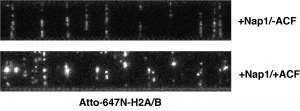DNA Curtains
 A powerful tool we use in the laboratory is DNA curtains in combination with single molecule total internal reflection microscopy (TIRFM). This technique allows us to directly visualize proteins and protein complexes as they function on DNA in real-time.
A powerful tool we use in the laboratory is DNA curtains in combination with single molecule total internal reflection microscopy (TIRFM). This technique allows us to directly visualize proteins and protein complexes as they function on DNA in real-time.
Chromatin
 DNA in the eukaryotic nucleus must be highly organized and compacted to fit into the confined space of the nucleus. High levels of organization and compaction are achieved using a number of different proteins and protein complexes that can be collectively referred to as chromatin. The basic fundamental repeating unit of chromatin is the called the nucleosome. Nucleosomes by themselves or in groups represent a challenge to many enzymes that work on DNA. A general goal of the lab will be to understand how nucleosomes organize into groups, how they inhibit proteins that function on DNA, and how that inhibition is overcome.
DNA in the eukaryotic nucleus must be highly organized and compacted to fit into the confined space of the nucleus. High levels of organization and compaction are achieved using a number of different proteins and protein complexes that can be collectively referred to as chromatin. The basic fundamental repeating unit of chromatin is the called the nucleosome. Nucleosomes by themselves or in groups represent a challenge to many enzymes that work on DNA. A general goal of the lab will be to understand how nucleosomes organize into groups, how they inhibit proteins that function on DNA, and how that inhibition is overcome.
Homologous Recombination (HR)
 HR is a universally conserved DNA damage repair pathway. HR functions by matching a damage piece of ssDNA (recipient DNA) with a homologous undamaged piece of dsDNA (donor DNA) elsewhere in the genome. Using the undamaged DNA as a template to repair the dsDNA break, thus restoring genomic integrity. In eukaryotes, there are two distinct types of HR. Mitotic HR that functions to repair dsDNA breaks in somatic cells, and meiotic HR which functions to ensure proper segregation of chromosomes in germline cells. In humans, failure in either of these pathways can have severe health consequences including the development of cancer, anueploidy related illnesses, and sterility. Therefore understanding how these two HR pathways are alike and how they are different provides a powerful mechanistic tool for understanding both pathways. A fundamental goal of the laboratory is to use reconstitution biochemistry in combination with single molecule imaging to compare and contrast how human mitotic and meiotic HR enzymes promote DNA repair.
HR is a universally conserved DNA damage repair pathway. HR functions by matching a damage piece of ssDNA (recipient DNA) with a homologous undamaged piece of dsDNA (donor DNA) elsewhere in the genome. Using the undamaged DNA as a template to repair the dsDNA break, thus restoring genomic integrity. In eukaryotes, there are two distinct types of HR. Mitotic HR that functions to repair dsDNA breaks in somatic cells, and meiotic HR which functions to ensure proper segregation of chromosomes in germline cells. In humans, failure in either of these pathways can have severe health consequences including the development of cancer, anueploidy related illnesses, and sterility. Therefore understanding how these two HR pathways are alike and how they are different provides a powerful mechanistic tool for understanding both pathways. A fundamental goal of the laboratory is to use reconstitution biochemistry in combination with single molecule imaging to compare and contrast how human mitotic and meiotic HR enzymes promote DNA repair.
The activity of DNA motor proteins
 DNA motor proteins control all aspects of DNA manipulation in cells including chromatin remodeling, separation of DNA strands, and nucleic acid intermediate processing. The active role these enzymes and their enzymatic complexes play in shaping the genome has made these motor proteins and active area of research. More recently it has become appreciated that DNA motor proteins represent a potential therapeutic target for human cancers. The strong link between between DNA motor proteins and human cancer, drives our laboratory to study the basic activity and organization of this highly diverse group of proteins.
DNA motor proteins control all aspects of DNA manipulation in cells including chromatin remodeling, separation of DNA strands, and nucleic acid intermediate processing. The active role these enzymes and their enzymatic complexes play in shaping the genome has made these motor proteins and active area of research. More recently it has become appreciated that DNA motor proteins represent a potential therapeutic target for human cancers. The strong link between between DNA motor proteins and human cancer, drives our laboratory to study the basic activity and organization of this highly diverse group of proteins.